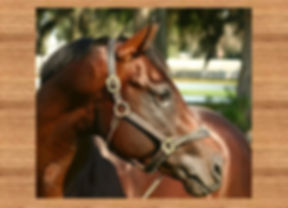A non-clinical synopsis of polyneuritis equi (PNE)
- sellison23
- Mar 31, 2022
- 4 min read
Updated: Dec 8, 2023

Beau Jackson was a competitive trail horse that was having difficulty in 2015. He had plunged into the river of inflammation and suffered from early polyneuritis. After consultation and treatment he successfully resumed competition, only to relapse two years later. His case was very useful to us and our studies in the early years.
Polyneuritis equi
Polyneuritis equi, PNE, is an uncommon neurological disease of mature horses and ponies. You probably read that PNE is untreatable. We know that isn't true! It is unfortunate that veterinarians aren't trained to consider the possibility that PNE is recognizable, and if treated before untreatable disease manifests, treatment can be life saving. Raising awareness about PNE will result in far fewer horses succumbing to life-ending disease. That is our goal, to raise awareness and bring an effective treatment to veterinarians and horse owners.
Rare equine diseases
You probably know someone with a horse with PNE. It is a rare disease, less than 50,000 horses a year are diagnosed with PNE. Rare diseases are not well funded and that means little information is generated about the biology, pathogenesis, or treatment possibilities. A disease needs to generate a baseline of income to interest Big Pharma. PNE doesn't qualify. Before a treatment can be considered, studies are used to lay a foundation of understanding of the pathogenesis of the disease, diagnosis, cause, and identifying treatable targets.
Before a treatment is considered it is wise to understand the unintended consequences of drugs, including the disease being treated, possible environmental impacts, and consequences in the animal. Did you know it is possible to induce a parasitemia in horses with some drugs? It has to do with dose and duration of therapy, and the target population. Before you pull a generic off the shelf make sure the prescriber has done their homework! Best if some of their data is published for you to review.
Science based information
The information we give you is based on experiment. Data is derived from experiments that were blinded, placebo controlled, and published in peer reviewed journals. Most of the raw material was provided to the researchers that were the blinded evaluators, so they had the opportunity to investigate as well. At every EPM meeting we fostered collaboration and shared our material. Did you know that is how the SN SAG 6 sequence was determined? We sent all our DNA from all our isolates to Dr. Michael Grigg, his lab is at NIH in Bethesda.
We read a paper Dr. Grigg co-authored, Sex and Self-Mating in Cyst-Forming Parasites in 2010, and followed up with a call. In that paper the authors made the statement:
The overall genetic diversity among S. neurona strains examined was surprisingly minimal, and just a few multi-locus genotypes were identified. This result could simply reflect the sample set used in this study, since it was composed predominantly of strains isolated form diseased animals...
We had stored samples that could help the Grigg lab! After his DNA analysis of our samples he discovered that the SAG 6 strain of S. falcatula (used in the University of Florida infection challenge experiments published by Cutler et. al) and the SAG 6 strain of S. neurona were nearly identical. Not identical, but nearly so. These findings had implications in the conclusions of the UF study and the ability to detect the SAG 6 strain of S. neurona infections in horses. Dr. Griggs later published his conclusions that it was unlikely that more serotypes of S. neurona would be discovered. That result led credence to our SAG 1, 5, and 6 ELISA tests. Remember that serotypes are based on mutually exclusive surface antigens displayed by the pathogenic protozoal parasite S. neurona. Until proven otherwise our testing is specific and yields more information that other testing.
We have ongoing studies. You know about the PNE field effectiveness study, but don't know yet about next steps for other inflammatory diseases in horses and people. One thing at a time! We learn more as we follow diseased/treated horses because we evaluate the data and pass it along to veterinarians involved in your cases. A large part of what we do is work toward a logical strategy to identify and manage PNE on a case by case basis. This is personalized medicine for your horse!
Recognizing PNE
Polyneuritis has an insidious onset. The subtle signs of PNE can be transient. Clinical signs will reappear and generally, the signs are progressive in severity. Sometimes an ineffective therapy is credited for the resolution of signs and with incomplete records the diagnosis is elusive. A defining characteristic of PNE is that it is progressive, chronic, and relapsing. Sounds like the description of equine protozoal myeloencephalitis (EPM) doesn't it? PNE is a sub-set of EPM cases. Possibly 55% of cases that are diagnosed as chronic, relapsing EPM are really misdiagnosed cases of PNE.
We say that cases of EPM are misdiagnosed based on experience and our years-long study of the diseases that look like EPM. You can read that paper if you like, use the button.
Beau Jackson

We know that Beau, and his owner Patricia, had a few more good rides because we were diligent at the bench. If you want to help our research and if you have a friend that says their horse was "diagnosed with EPM but failed to recover"...have them contact us. Or better yet, have their veterinarian send us a sample and set up a consult. This is a time sensitive suggestion! The longer a horse goes undiagnosed and untreated, the higher the possibility the disease will progress to an untreatable state.


